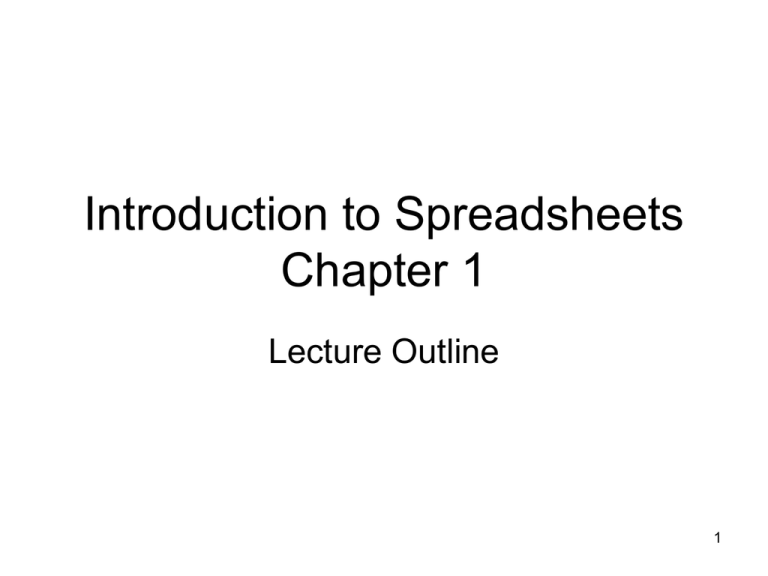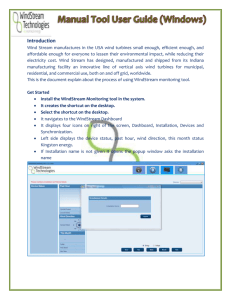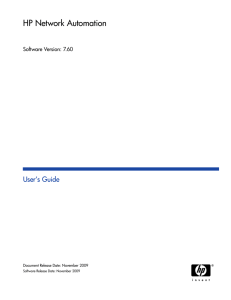Excel Ch1 Power Point Snow Days
advertisement

Introduction to Spreadsheets Chapter 1 Lecture Outline 1 Microsoft Excel/Apple Numbers: • A powerful spreadsheet program that allows you to: • Organize data • Complete calculations • Make decisions • Graph data • Develop professional looking reports • Published organized data to web • Access real-time data from web sites 2 Workbook: • A collection of worksheets • Contains 3 worksheets by default 3 Worksheet: • A sheet where data is entered • A workbook can contain 255 worksheets in one file 4 Worksheet: • Column heading- labels 256 columns with letters • Row heading- labels 65,536 rows with numbers • How big is a worksheet???- 2 rooms wide by 4 rooms long • Cell- intersection of a row and column • Active cell- the one cell with the thick border where data will be entered (similar to flashing insertion point) • Cell reference- unique address of a cell; combine column letter with row number (coordinates) 5 15 possible mouse shapes: • Note to self: page 1 of Spreadsheet Ch1 draw top 5 most used shapes • BIG BLOCK- displays inside a cell; used to block a range of cells • LITTLE “FILL” PHIL- displays when touching the fill handle 6 5 Most Used Mouse Shapes: • 1-displays when outside the worksheet; used to drag and drop contents • 2-displays when inside a cell; used to block a range of cells (big block) • 3-displays when touching the fill handle (Little Phil) • 4- displays when inside a row heading; used to select an entire row • 5- displays when inside a column heading; used to select an entire column 7 Name Box: • Used to (1) display active cell reference; (2) navigate active cell, or (3) name a range of cells • Click once in cell you want to activate • OR: • Type column & row of desired cell then [enter] 8 Formula bar: • Displays data being typed and formulas keyed 9 Status Bar: • Displays brief description of the command selected in a menu • Displays the function of the button on which the mouse is pointing • Displays the function of the mode currently enacted. 10 Status Bar: • Mode indicators- display to specify current mode of Excel (enter, ready, edit) • Autocalculate area- used to view the sum, average, or other totals of a group of numbers 11 Fonts and Font Size: • • • • • • Default: Arial, size 10pt Font Conversions: same as Word 1”- 72 point 2”- 144 point ½”- 36 point ¼”-18 point 12 2 Ways to Enter Text: • [enter] • Enter box on formula bar (check inside box) 13 Enter/Cancel Boxes: • Displays on the formula bar when data is typed and is used to enter the data (check inside box) • Displays on the formula bar when data is typed and is used to cancel the data (x inside box) 14 2 Types of Data: • Labels: text that identifies contents of a spreadsheet Label default alignment=left • Values: numeric data in the form of [1] numbers, [2] formulas, or [3] functions • Value default alignment=right 15 Functions/Formulas • • • • There are 3 rules for writing a function: [1] always start with = [2] type the function’s name [3] type the argument (a range separated by a colon) • *identify by cells, not numbers addressed! 16 Range: • A rectangular group of adjacent cells 17 AutoSum: • 2 Ways to Activate Auto sum: =sum(1st cell: last cell) or…. AutoSum button on the Standard Toolbar 18 Auto fill: • A feature used to fill adjacent cells with the same or consecutive data. • Fill Handle- a small black square in lower right corner of active cell. 19 3 Steps to Auto fill: • Place active cell on cell containing data to copy • Place mouse on active cell's fill handle • Drag fill handle to adjacent cells to fill in data 20 Why Auto fill Works?? • Relative Reference- cell addresses that will adjust to the position to which formulas or functions are being copied or moved. 21 Merge & Center: • Select the individual cells to merge • Click the “merge and center” button on the formatting toolbar (not the center button) 22 Autoformat: • Preset customized format styles that can be applied to a table 23 Steps to Autoformat • Select the cells to be formatted • Format menu • Autoformat command 24 You MUST know your mathematical procedures!!!!! • “Please Excuse My Dear Aunt Sally” 25 PEMDAS • • • • • • P- parentheses E- exponents M- multiply D- divide A- addition S- subtraction 26 Solve this problem: • 10-4/(2*4)+6= ? 27 This is what you should have: • 15.5 or 15 ½ 28 CHARTS • Embedded Chart- A chart that is placed within the same worksheet as the data • Steps to Use a Chart Wizard: – Select the range of cells to chart – Click “chart wizard” button on standard toolbar – Answer wizard questions 29 CHARTS: • Steps to Align Chart within Gridlines: – Select chart so that resize handles appear – Hold [alt] key on keyboard – Drag chart border with resize mouse 30 CHARTS • Parts of a Chart: – Y-axis or Value axis…. Derived from the values within the worksheet; sets increments automatically – X-axis or Category axis…. Excel automatically selects entries in topmost row – Legend….identifies what each chart section represents 31 AUTOCALCULATE: • Steps to Use AutoCalculate: – Select range of cells containing the numbers – Right click “autocalculate” area on status bar – Choose command from short-cut menu 32 CORRECTING ERRORS: • Edit BEFORE Entering: – [backspace] or – X or cancel button Edit AFTER Entering: -Retype new entry on top of old entry or.. -double click in cell with error or… -place active cell on cell containing error and singleclick on formula bar or… -[F2] on cell containing error 33 CLEARING CELLS • Steps to Clear Contents but leave formatting: – Select cells – [delete] Or… -select cells -edit menu -clear command -contents 34 Clearing Cells: • Steps to Clear Formatting but Leave Contents: – Select cells – Edit menu – Clear command – Contents Or -Select cells - [delete] 35 Clearing Cells: • Steps to clear formatting but leave contents: • Select cells • Edit menu • Clear command • Formats 36 Clearing Cells: • • • • • Steps to clear contents and formatting: Select cells Edit menu Clear command All 37 SELECT ALL: • “select all” button on worksheet or… • Edit menu- select all command or… • [ctrl] + [A] 38






